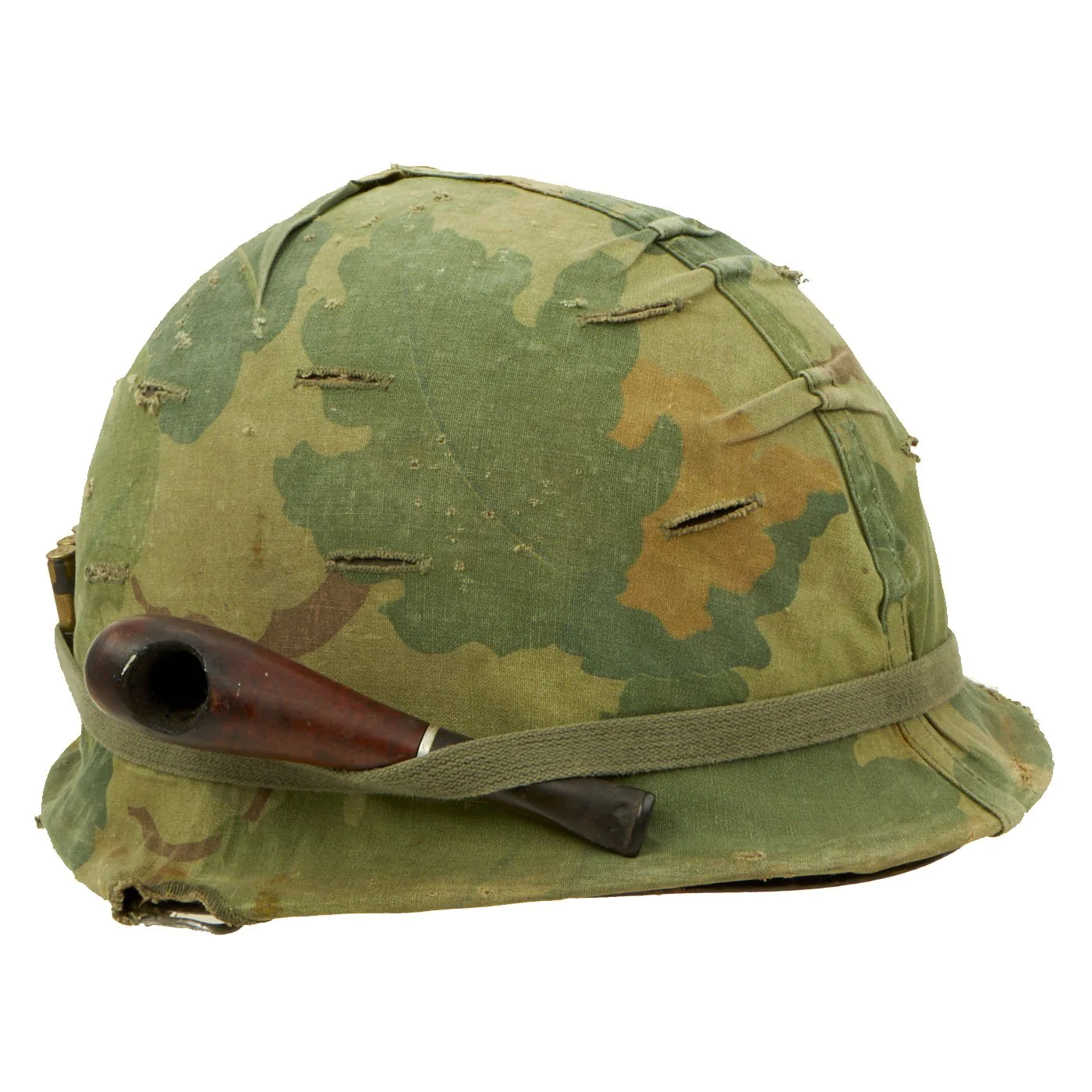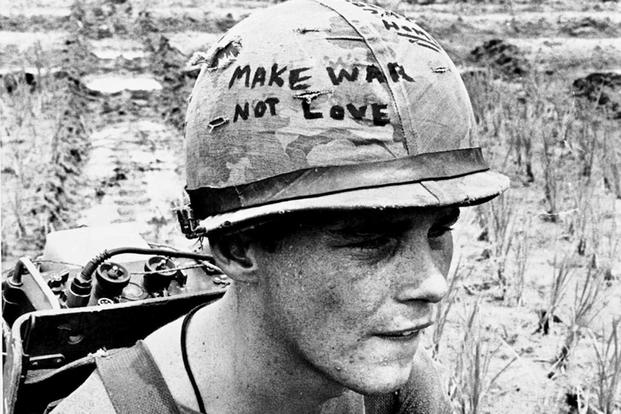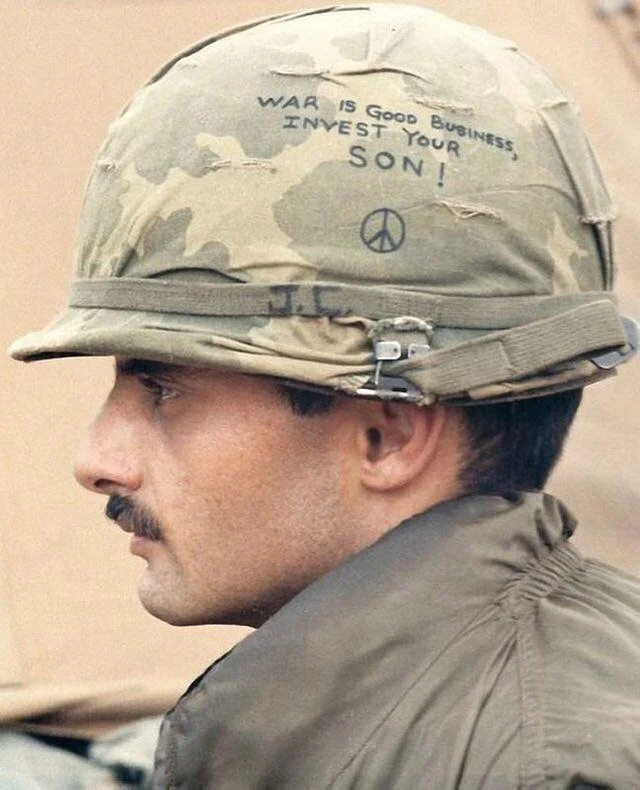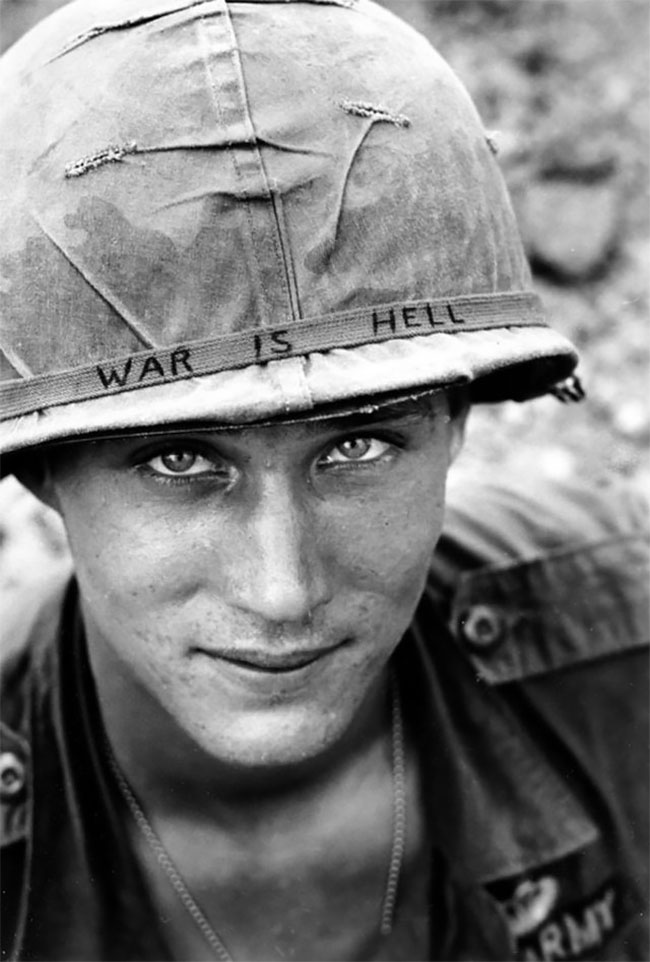The Vietnam War must be known to all Vietnamese or American people. But the stories behind the war, especially about the helmet worn by American soldiers, probably not many people know. One of the enduring images of the Vietnam War is of Army or Marine infantrymen, sitting in the jungle or around rice paddies, wearing graffiti helmets. So what is their meaning? Today, let’s learn about the Vietnam helmet graffiti and the art of expressing yourself through the helmet with this article.
Contents
Introducing the American Helmet in the Vietnam war
American soldier symbol

The M1 is built to a one-size-fits-all standard. The depth of the hat is about 18cm, the width is 24cm and the length is 28cm, and the weight of the hat is about 1.3 kg. The main part of the helmet is a metal shell, sometimes called a “steel pot”, the outer part of which is painted according to the uniform of the unit used. Inside this metal, the case is a suspension system that can be adjusted to fit the size of the wearer’s head.
The outer part uses a sheath or mesh to reduce the reflection of light from the iron shell or camouflage according to the terrain. Users can add more leaves to increase camouflage. In addition, the helmet’s headband allows the soldier to carry useful small items such as mosquito repellent or cigarettes, or even LSA lubricant for ammo and weapons. For more than 40 years of use, the M1 helmet has become an icon of American soldiers, even as it has been replaced by new lighter, more protective helmets.
Why don’t American soldiers like to wear the straps of their hats?
The M1 helmet only works to help American soldiers reduce the level of casualties caused by shrapnel caused by bombs, bullets, grenades, mines, etc. AK-47 or M-16… If the firing distance is long as well as the angle of impact between the bullet and the helmet is small, the bullet will bounce and cause a dent in the helmet, avoiding casualties for the wearer. If the distance is close and the collision angle between the bullet and the helmet is almost perpendicular, the bullet will easily penetrate the helmet and deal damage. The many helmets left over from the battle with punctures caused by bullets testify to this.
One thing that makes many people wonder is why American soldiers when using M1 helmets rarely use the chin strap but often release it. This is explained by the following two reasons: One is that American soldiers in general are afraid of fighting with Vietnamese troops, especially being hit by surprise from behind. At that time, the opponent can take advantage of the chin strap to squeeze the throat. Second, American soldiers were afraid that when the bombs exploded near, under the pressure of the explosion, the helmet might be thrown backward and the chin strap would suddenly squeeze the throat.
For the above two reasons, despite being prevented by a smart helmet lock that will automatically unfold when reaching a certain pulling force, American soldiers still carry fear, so they still very limited use of chin straps in the battle fight.
The Interesting Story of Vietnam Helmet Graffiti
The origin of the Vietnam helmet graffiti

The fact that graffiti is not often seen outside of the Vietnam war is due to the fact that it is a bit counterproductive to keep order and maintain uniformity between militaries if there is scribbling on helmets among all different soldiers. On top of that, it can make the soldier an easy target for enemy snipers. But this war is very different from other wars because it pits a technologically advanced superpower against a weaker armed force with extreme determination.
This war exposed American soldiers to brutal conditions that eroded many of their regular military advantages as tanks were nearly useless in Vietnam’s jungle terrain and strategic bombing virtually inefficient. Thus the war came as a complete shock to the inexperienced conscripts of the US army, so as an act of rebellion, many young soldiers began to decorate their metal helmets.
The meaning of Vietnam helmet graffiti
These lines are meant to express their personality, first the name of their girlfriend, the name of their home city, state, or even the name of their favorite band. But as the war was being pushed to the top, slogan symbols and scribbles began to appear on military hats with many anti-war messages whether it was subconscious anti-war messages or not. Being conscious, some soldiers even wrote down the calendar of their mission trip and marked each passing month as proof of survival or marking the date of return home.

The simple calendar was a popular doodle in which soldiers recorded the months of their travels and then crossed them out as time passed and they lived another thirty days. Such “short-term timer” schedules are common among conscripts as they await their trip on duty. The media found out about this and wanted to report and photograph the helmets.
Many senior officers did not like this and asked soldiers to stay away from photographers. Appearing in an Associated Press article by Pulitzer Prize-winning photographer Horst Faas, the photo caption shows Larry Wayne Chaffin of the 173rd Airborne Brigade, embodying a simple but powerful message on his hat. : “WAR IS HELL.” Additionally, the picture infuriated anti-war protestors who were enraged by the battle even more.

But today we still see a lot of pictures of graffiti helmets. Some soldiers do graffiti on their helmets because they want to express themselves, others get bored and see other people do it and follow suit. Vietnam War veterans say graffiti depends on the outfit you’re attached to and is generally OK as long as it doesn’t detract from the purpose of combat camouflage. The rule is, that as long as the graffiti doesn’t discredit the Marines, the United States, or the chain of command, it doesn’t matter what you wrote or how you wrote it. The truth is that these helmets are all so unique and highly personalized, that we think it’s great works of art.
To sum up, writing graffiti on our helmets is part of Vietnamese history. Currently, these hats are bought by many collectors of memorabilia at very high prices. Whether perceived as graffiti, artwork, or simply boring doodles of young men forced into military service in a land far from their homeland, one’s helmet The soldier is his life as well as the rifle. In a way, it seems too trivial. Appropriately or not, their artwork survives as a reminder of a brutal war that many would like to forget. Our article today has analyzed Vietnam helmet graffiti and the meaning contained within it. Hope to bring a lot of information and really useful to you.
Read more:
Video- Source from Simple History (Youtube)
